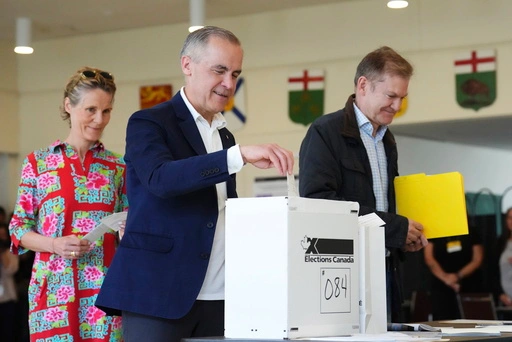The Canada election has wrapped up with a nail-biting finish, and the latest news is buzzing with Mark Carney’s Liberals clinching a minority government. Announced on April 29, 2025, by CTV News, this outcome marks a stunning turnaround for the Liberal Party, which was trailing badly in polls just months ago. Fueled by fears over U.S. President Donald Trump’s tariff threats and provocative annexation rhetoric, voters rallied behind Carney’s promise of stability. But with a minority government, the road ahead looks tricky—Carney will need to court opposition parties to govern effectively. This election wasn’t just about domestic issues; it was a referendum on Canada’s resilience against external pressures. Let’s dive into what happened, why it matters, and what’s next.
The Canada Election Comeback: Liberals Defy Odds
Back in January, the Liberals were staring at a grim horizon, lagging 20 points behind Pierre Poilievre’s Conservatives. Justin Trudeau’s resignation, after a decade of leadership marred by internal strife, seemed like the final nail in the coffin. Enter Mark Carney, a former central banker with no prior elected office, who took the reins in March. His campaign leaned heavily on his economic credentials—having steered the Bank of Canada through the 2008 crisis and the Bank of England during Brexit. Carney pitched himself as the steady hand to navigate Trump’s trade war, a message that resonated as Trump’s threats loomed larger. By election day, polls showed the Liberals at 43%, edging out the Conservatives at 39%. The Canada election results, with 52% of polls reporting, gave the Liberals 108 seats to the Conservatives’ 114, falling short of the 172 needed for a majority.
Key Factors Shaping the Canada Election
What turned the tide? Here’s a breakdown of the forces at play:
- Trump’s Shadow: Trump’s tariffs and annexation comments sparked patriotic fervor, pushing voters toward Carney’s “Trump-proof Canada” platform.
- Trudeau’s Exit: His departure lifted the Liberals from the weight of his unpopularity, giving Carney a fresh slate.
- Poilievre’s Stumble: The Conservative leader’s aggressive style, likened to Trump’s, alienated some moderate voters.
- Strategic Voting: NDP supporters, like those in Toronto’s Taiaiako’n–Parkdale—High Park, swung to the Liberals to block a Conservative win.
This election saw a record 7.3 million early ballots, reflecting high stakes and voter engagement. Yet, challenges like website glitches at Elections Canada frustrated some, highlighting logistical hurdles in this critical vote.
Minority Government: What It Means for Canada
A minority government is a delicate balancing act. Carney’s Liberals, projected to form the government, will need support from parties like the NDP or Bloc Québécois to pass legislation. The Bloc, with 18 seats, could hold significant sway, especially on Quebec-centric issues. The NDP, however, faces a rough patch—early results show them shut out in Ontario, a blow to Jagmeet Singh’s influence. For Carney, this means constant negotiation, potentially diluting his agenda. His immediate challenge? Addressing Trump’s tariffs, which threaten Canada’s economy. Voters like Christine Lussier, 55, backed Carney for his business acumen, hoping he can shield their retirement savings from U.S.-induced economic turbulence. But with a divided Parliament, bold moves might take a backseat to political horse-trading.
Voices from the Ground
The Canada election wasn’t just numbers—it was personal. In Ottawa, Liberal supporters erupted in cheers at Carney’s headquarters, their relief palpable after months of uncertainty. Meanwhile, in Alberta, Conservative strongholds painted the map blue, showing Poilievre’s base remains fierce. Jack DeWitt, a 19-year-old music student, voted Conservative, frustrated by a decade of Liberal policies. On X, sentiments echoed the divide: @saiyed_nida celebrated the Liberal win as a “remarkable reversal,” while @MrJoKeR604 had predicted Carney’s triumph, calling Poilievre’s collapse “biblical.” These voices underscore a polarized nation, where economic fears and national pride collided. Carney’s challenge now is uniting these perspectives while facing a combative U.S. administration.
Looking Ahead: Carney’s Tightrope Walk
As Carney prepares to lead, the world watches. His economic expertise is a double-edged sword—voters expect results, not just promises. The Canadian dollar weakened on news of a minority government, signaling market jitters. Trade talks with the U.S. are urgent, with Trump’s policies threatening jobs and prices. At home, Carney must address cost-of-living concerns, a persistent thorn from Trudeau’s era. Poilievre, though defeated, isn’t going anywhere; his 114 seats ensure a vocal opposition. Smaller parties, like the Greens and Bloc, could tip the scales in key votes. The Canada election has set the stage for a high-stakes term, where every decision will be scrutinized. Carney’s ability to deliver stability while juggling coalition politics will define Canada’s path forward.
Why This Election Matters Globally
This wasn’t just Canada’s moment—it was a signal to the world. The Liberal win reflects a rejection of populist rhetoric akin to Trump’s, favoring pragmatic leadership. Carney’s global experience positions him to strengthen Canada’s voice in trade and climate talks. Yet, a minority government limits his leverage, both domestically and abroad. For Canadians, this election was about sovereignty and survival in a turbulent era. As one voter, Raymond Thibert, 67, put it, “Carney’s the guy to keep us steady.” Whether he can deliver remains the million-dollar question. The Canada election has drawn a line in the sand—Canada’s ready to fight for its place, but the battle’s just begun. Stay tuned as this story unfolds, with Carney at the helm of a nation on edge.
